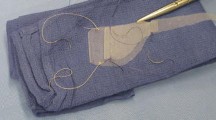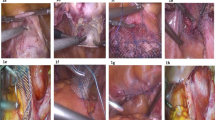Abstract
We aimed to assess the subjective and objective outcomes 1 year after robotic sacrocolpopexy using a type I polypropylene mesh. This was a case series of 64 patients who underwent a robotic-assisted laparoscopic sacrocolpopexy using a type I monofilament polypropylene mesh coated with hydrophilic porcine collagen. Objective and subjective outcomes were assessed using the pelvic organ prolapse quantification (POP-Q), the short forms of the Pelvic Floor Impact Questionnaire (PFIQ 7) and the Pelvic Floor Distress Inventory (PFDI-20). Outcome measures were collected pre-operatively and 1 year post-operatively on all but one patient, who was lost to follow-up. Paired comparisons between pre- and post-operative outcomes were performed using the Wilcoxon signed rank test. At 1 year, POP-Q stage II or greater and loss of follow-up were considered to be surgical failure. The “surgical cure” rate was 89%. We observed three distal anterior failures, two distal posterior failures and one apical failure, and one patient was lost to follow-up. We found significant differences between pre- and post-operative POP-Q measurements (p < 0.001) and PFDI-20/PFIQ-7 total scores (p < 0.001). Robotic sacrocolpopexy using this polypropylene mesh resulted in significant improvements in subjective and objective outcome measures at 1 year.
Similar content being viewed by others
References
Haylen BT, de Ridder D, Freeman RM et al (2010) An International Urogynecological Association (IUGA)/International Continence Society (ICS) joint report on the terminology for female pelvic floor dysfunction. Neurourol Urodyn 29:4–20
Jelovesk JE, Maher C, Barber MD (2007) Pelvic organ prolapse. Lancet 369:1027–1038
Olsen AL, Smith VJ, Bergstorm JO et al (1997) Epidemiology of surgically managed pelvic organ prolapse and urinary incontinence. Obstet Gynecol 89:501–506
Nygaard IE, McCreery R, Brubaker L et al (2004) Abdominal sacrocolpopexy: a comprehensive review. Obstet Gynecol 104:805–823
Culligan PJ, Murphy M, Blackwell L et al (2002) Long-term success of abdominal sacral colpopexy using synthetic mesh. Am J Obstet Gynecol 187:1473–1482
Diwadkar GB, Barber MD, Feiner B et al (2009) Complication and reoperation rates after apical vaginal prolapse surgical repair. Obstet Gynecol 113:367–373
Paraiso MF, Walters MD, Rackley RR et al (2005) Laparoscopic and abdominal sacral colpopexies: a comparative cohort study. Am J Obstet Gynecol 192:1752–1758
Geller EJ, Siddiqui NY, Wu JM et al (2005) Short-term outcomes of robotic sacrocolpopexy compared with abdominal sacrocolpopexy. Obstet Gynecol 112:1201–1206
Elliott DS, Krambeck AE, Chow GK (2006) Long-term results of robotic assisted laparoscopic sacrocolpopexy for the treatment of high-grade vaginal vault prolpase. J Urol 176:655–659
Elliott DS, Frank I, Di Marco DS et al (2004) Gynecologic use of robotically assisted laparoscopy: sacrocolpopexy for the treatment of high-grade vaginal vault prolapse. Am J Surg 188:52S–56S
Di Marco DS, Chow GK, Gettman MT et al (2004) Robotic-assisted laparoscopic sacrocolpopexy for treatment of vaginal vault prolapse. Urology 63:373–376
Ayav A, Bresler L, Hubert J et al (2005) Robotic-assisted pelvic organ prolapse surgery. Surg Endosc 19:1200–1203
Daneshgari F, Kefer JC, Moore C et al (2007) Robotic abdominal sacrocolpopexy/sacrouteropexy repair of advanced female pelvic organ prolapse (POP): utilizing POP-quantification-based staging and outcomes. BJU Int 100:875–879
Akl MN, Long JB, Giles DL et al (2009) Robotic-assisted sacrocolpopexy: technique and learning curve. Surg Endosc 23:2390–2394
Salamon C, Shariati A, Culligan PJ (2010) Optimizing efficiency with robot-assisted laparoscopic sacrocolpopexy. Female Patient 35(4):33–38
White AB, Carrick KS, Corton MM et al (2009) Optimal location and orientation of suture placement in abdominal sacrocolpopexy. Obstet Gynecol 113:1098–1103
Barber MD, Walters MD, Bump RC (2005) Short forms of two condition-specific quality of life questionnaires for women with pelvic floor disorder (PFDI-20 and PFIQ-7). Am J Obstet Gynecol 193:103–113
Murphy M, Sternschuss G, Haff R et al (2008) Quality of life and surgical satisfaction after vaginal reconstructive vs obliterative surgery for the treatment of advanced pelvic organ prolapsed. Am J Obstet Gynecol 198:573.e1–573.e7
Conflict of interest
Dr. Salamon is a paid consultant for Intuitive Surgical. Dr. Culligan is a paid consultant for CR Bard and Intuitive Surgical.
Author information
Authors and Affiliations
Corresponding author
Rights and permissions
About this article
Cite this article
Salamon, C.G., Culligan, P.J. Subjective and objective outcomes 1 year after robotic-assisted laparoscopic sacrocolpopexy. J Robotic Surg 7, 35–38 (2013). https://doi.org/10.1007/s11701-012-0337-4
Received:
Accepted:
Published:
Issue Date:
DOI: https://doi.org/10.1007/s11701-012-0337-4




